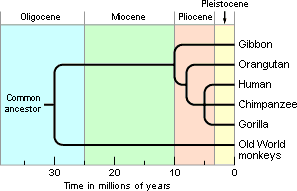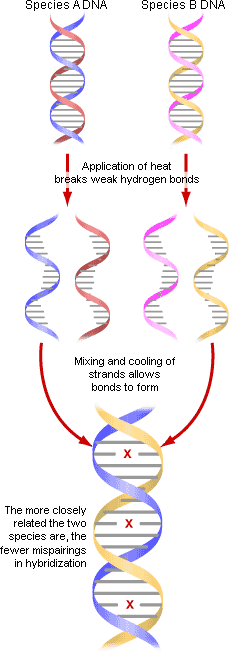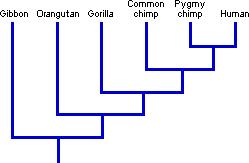To investigate how birds are related to one another, a biologist of the 1950s would have carefully studied their anatomical similarities and differences. But today, a scientist working on the same problem could also use the very instructions from which that anatomy was built: its genetic code. DNA sequences form the hereditary links between generations, so it is no surprise that scientists investigating evolutionary relationships have sought to get closer and closer to the DNA that underlies those relationships. However, reading the genomes of entire organisms did not fall immediately from the discovery of DNA in the 1950s. In small steps, scientists came closer to their target.
Scientists first began to zoom in on gene sequences by studying the products of DNA: proteins. After all, if two species are closely related, they should have similar gene sequences, which should then make similar proteins. So before the 1970s, proteins were used as stand-ins for genes in studying evolution.
Testing similarity using antibodies


One way that researchers assessed protein similarities was by harnessing the immune system’s ability to recognize foreign proteins. For example, the immune system of a rabbit will recognize a human protein as foreign and will mount an attack against it by making antibodies specific to that protein. If those same rabbit antibodies are exposed to a similar protein — from a chimpanzee, perhaps — they will attack it as well. The more similar the proteins from the two species (human and chimpanzee) are, the stronger this second attack will be. Although variations of this technique were being employed as early as 1904, more sensitive protocols were developed in the 1960s. These more sensitive techniques revealed the remarkable similarity between the proteins of humans and those of other great apes. Expanding upon the work of others and making the assumption that fewer protein differences corresponded to shorter times of separation, Vincent Sarich (above left) and Allan Wilson (above right) estimated that humans, chimpanzees, and gorillas shared a common ancestor only 5 million years ago — a much shorter length of time than was commonly accepted at the time.

Testing similarity using DNA

 Scientists studying the chemistry of DNA moved even closer to actual sequences. Charles Sibley (left) and Jon Ahlquist pioneered the use of DNA kinetics to investigate evolutionary relationships using a technique called DNA-DNA hybridization (see figure, right). Each DNA molecule is made of two strands of nucleotides. If the strands are heated, they will separate—and as they cool, the attraction of the nucleotides will make them bond back together again. To compare different species, scientists cut the DNA of the species into small segments, separate the strands, and mix the DNA together. When the two species’ DNA bonds together, the match between the two strands will not be perfect since there are genetic differences between the species — and the more imperfect the match, the weaker the bond between the two strands. These weak bonds can be broken with just a little heat, while closer matches require more heat to separate the strands again.
Scientists studying the chemistry of DNA moved even closer to actual sequences. Charles Sibley (left) and Jon Ahlquist pioneered the use of DNA kinetics to investigate evolutionary relationships using a technique called DNA-DNA hybridization (see figure, right). Each DNA molecule is made of two strands of nucleotides. If the strands are heated, they will separate—and as they cool, the attraction of the nucleotides will make them bond back together again. To compare different species, scientists cut the DNA of the species into small segments, separate the strands, and mix the DNA together. When the two species’ DNA bonds together, the match between the two strands will not be perfect since there are genetic differences between the species — and the more imperfect the match, the weaker the bond between the two strands. These weak bonds can be broken with just a little heat, while closer matches require more heat to separate the strands again.
DNA hybridization can measure how similar the DNA of different species is — more similar DNA hybrids “melt” at higher temperatures. When this technique was applied to primate relationships, it suggested that humans and chimpanzees carried DNA more similar to one another’s than to orangutans’ or gorillas’ DNA.

Sequencing DNA

The first DNA sequencing methods were invented in the late 1970s, but pure DNA, ready for sequencing, was difficult to produce — thus, making DNA sequencing labor- and time-intensive compared to other tools for making indirect inferences about genetic sequences. However, in the late 1980s, scientists developed a technique for producing many, many copies of a very small amount of DNA, and this invention sparked an explosion in the study of DNA sequences. Researchers began to rely upon sequences as a crucial source of evidence for evolutionary relationships.
Sequencing genes seems to become easier every day. Ten years ago, it might have taken an hour to sequence 10 base pairs. Today a typical lab can sequence 100 base pairs in an hour and facilities with the latest technology sequence hundreds of base pairs each minute. We are now awash in genetic code — we have a basic map of the human genome and the genomes of many other organisms. However, DNA sequences alone do not answer all the questions that biologists ask, and knowing a gene’s sequence is still many steps away from understanding how it actually works and what it does. DNA sequences are only one line of evidence illuminating evolutionary relationships. For example, human and chimpanzee DNA is 98% identical, and genetic sequencing can tell us exactly where in the genome those few DNA differences are — but anatomical, behavioral, and developmental studies are also crucial in deeply understanding our differences, similarities, and shared evolutionary history.
